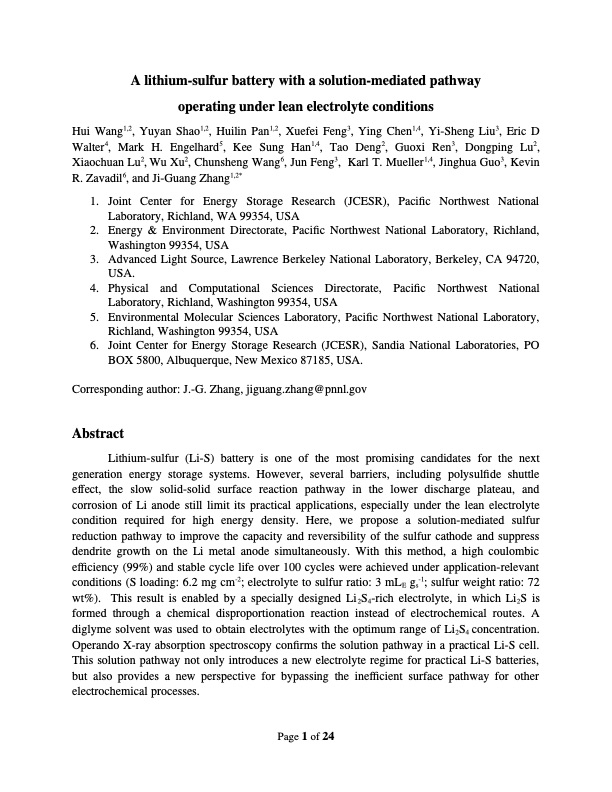
PDF Publication Title:
Text from PDF Page: 001
A lithium-sulfur battery with a solution-mediated pathway operating under lean electrolyte conditions Hui Wang1,2, Yuyan Shao1,2, Huilin Pan1,2, Xuefei Feng3, Ying Chen1,4, Yi-Sheng Liu3, Eric D Walter4, Mark H. Engelhard5, Kee Sung Han1,4, Tao Deng2, Guoxi Ren3, Dongping Lu2, Xiaochuan Lu2, Wu Xu2, Chunsheng Wang6, Jun Feng3, Karl T. Mueller1,4, Jinghua Guo3, Kevin R. Zavadil6, and Ji-Guang Zhang1,2* 1. Joint Center for Energy Storage Research (JCESR), Pacific Northwest National Laboratory, Richland, WA 99354, USA 2. Energy & Environment Directorate, Pacific Northwest National Laboratory, Richland, Washington 99354, USA 3. Advanced Light Source, Lawrence Berkeley National Laboratory, Berkeley, CA 94720, USA. 4. Physical and Computational Sciences Directorate, Pacific Northwest National Laboratory, Richland, Washington 99354, USA 5. Environmental Molecular Sciences Laboratory, Pacific Northwest National Laboratory, Richland, Washington 99354, USA 6. Joint Center for Energy Storage Research (JCESR), Sandia National Laboratories, PO BOX 5800, Albuquerque, New Mexico 87185, USA. Corresponding author: J.-G. Zhang, jiguang.zhang@pnnl.gov Abstract Lithium-sulfur (Li-S) battery is one of the most promising candidates for the next generation energy storage systems. However, several barriers, including polysulfide shuttle effect, the slow solid-solid surface reaction pathway in the lower discharge plateau, and corrosion of Li anode still limit its practical applications, especially under the lean electrolyte condition required for high energy density. Here, we propose a solution-mediated sulfur reduction pathway to improve the capacity and reversibility of the sulfur cathode and suppress dendrite growth on the Li metal anode simultaneously. With this method, a high coulombic efficiency (99%) and stable cycle life over 100 cycles were achieved under application-relevant conditions (S loading: 6.2 mg cm-2; electrolyte to sulfur ratio: 3 mLE gs-1; sulfur weight ratio: 72 wt%). This result is enabled by a specially designed Li2S4-rich electrolyte, in which Li2S is formed through a chemical disproportionation reaction instead of electrochemical routes. A diglyme solvent was used to obtain electrolytes with the optimum range of Li2S4 concentration. Operando X-ray absorption spectroscopy confirms the solution pathway in a practical Li-S cell. This solution pathway not only introduces a new electrolyte regime for practical Li-S batteries, but also provides a new perspective for bypassing the inefficient surface pathway for other electrochemical processes. Page 1 of 24PDF Image | A lithium-sulfur battery with a solution-mediated pathway

PDF Search Title:
A lithium-sulfur battery with a solution-mediated pathwayOriginal File Name Searched:
qt9bt5f7wt_noSplash_4e336387563ecb2106bd171b37448483.pdfDIY PDF Search: Google It | Yahoo | Bing
Sulfur Deposition on Carbon Nanofibers using Supercritical CO2 Sulfur Deposition on Carbon Nanofibers using Supercritical CO2. Gamma sulfur also known as mother of pearl sulfur and nacreous sulfur... More Info
CO2 Organic Rankine Cycle Experimenter Platform The supercritical CO2 phase change system is both a heat pump and organic rankine cycle which can be used for those purposes and as a supercritical extractor for advanced subcritical and supercritical extraction technology. Uses include producing nanoparticles, precious metal CO2 extraction, lithium battery recycling, and other applications... More Info
| CONTACT TEL: 608-238-6001 Email: greg@infinityturbine.com | RSS | AMP |